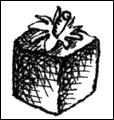Are you a journalist? Please sign up here for our press releases
Subscribe to our monthly newsletter:

If you've ever lived in a city and attempted to grow tomatoes in a windowbox, this story is for you. If you just plain like tomatoes or Jonathan Swift, or for that matter, boutiques and designer tags dangling from your jeans, oops, we mean genes, read on. Couture fruits and vegetables rather than pret-a-manger? If the word "mutation" has a certain attractive ring to it, settle back and read awhile.
A tiny tomato, dubbed "Micro-Tom," is making giant strides in genetic engineering. The Lilliputian plant, now adapted for research, is the key to a new method that may speed the process of unraveling the genetic code of plants, making it easier to identify and capitalize on these commercially-valuable genes. The man behind the mutation is Dr. Avraham Levy of the Plant Sciences Department.
Working with Dr. Yoni Elkind of the Hebrew University of Jerusalem and Ph.D. student Rafi Meissner, Levy has taken Micro-Tom, a humble plant bred for city dwellers with limited gardening space, and joined it with a unique combination of technologies in order to speed up mutagenesis, the creation of new mutant plant strains.
Levy is addressing mutagenesis with a major breakthrough in miniature. Levy's Micro-Tom, which puts out fruit twice as fast as conventional tomatoes, cuts in half the time necessary to produce such mutations. Too, it drastically reduces the amount of greenhouse space necessary for cultivating new mutant plant strains, making it easier to work with sizeable plant populations. With the Micro-Tom, Levy can grow up to 1,000 plants per square meter as opposed to five plants per square meter in the case of normal tomatoes. That's more than a 99% reduction in greenhouse space. And its rapid growth cycle allows Levy and team to cultivate four generations per year as opposed to the usual two.
Levy's method also makes mutations easier to analyze. Prevailing techniques, which use chemicals or radiation to create a mutant plant, result in random mutations that are difficult to trace to a particular spot in the plant's genetic code. The new technique differs, marking the plant genome with easily-identified genetic "tags" (a group of readable, genetic characters) that allow Levy to locate the exact spot where a mutation has taken place.
This traceability, together with the use of large plant populations, makes it feasible to identify the function of any plant gene. "If earlier techniques for creating mutations are something like playing the lottery," says Levy, "with this new method, we can buy all the tickets."
In recent years, scientific advances have made it easier to identify genes and their function, creating the tantalizing possibility of a genetic "boutique" where plant breeders may browse among thousands of traits and select genetic material for customizing fruits and vegetables. Previously, before such a boutique would open its doors, each trait in the "inventory" had to be produced in an isolated, living plant a process that required the time-consuming sleuthing of approximately 50,000 genes and an estimated 100,000-plus tomato plants. Enter Levy and team, speedmeisters of the produce fast track.
Levy's technique was designed for use on tomatoes, one of the most important crops for the fresh and processed food industries. But the method can be applied to any crop where farmers are interested in engineering new, more marketable strains.
So the next time you're in the supermarket pinching, sniffing, or humming "You say tomayto, And I say tomahto," think of Dr. Levy. His research may lead to a veritable cornucopia of 21st century palatepleasers.